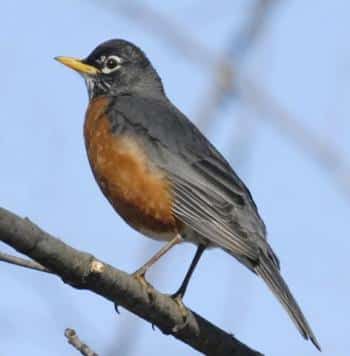Spring is Robin Season

American Robin
Photo credit: Jim Williams
by Val Cunningham
Contributing Writer
Spring moves toward us at its own plodding pace, “migrating” northward about 15 miles a day, a measure of the rate at which frost leaves the soil.
No beings know this better than the American robin, those big, bright thrushes that follow behind the spring thaw. In one of nature’s many synchronicities, robin migration coincides with earthworm migration. After a winter spent below ground, the worms rise to the surface once the soil is ice-free. Trailing behind the thaw on favorable winds, robins drop down in backyards, parks and boulevards ready to snap up shiny, brown worms as they emerge.
Let’s deal with a vexing question right away: robins are reported in our area throughout the winter, so how can they be called migrants? The answer is that robins are true migrants, with most of their populations moving north and then south with the seasons. A number of birds choose to trade the dangers of biennial journeys for the perils of a northern winter.
The new arrivals generally have had an easier time of it over the winter and it shows: their feathers seem almost new and many are just plain fat, there’s no kinder word. After gorging on worms and berries in the Gulf States and along the Atlantic coast, some arrive in nearly obese condition. Viewed from behind, these birds show orange ellipses of plumpness, bulging out from either side.
The rigors of defending a territory and the trials of the nesting season will soon pare these birds down to standard size.
Male robins are in the vanguard, arriving about two weeks before their female counterparts. Traveling in flocks, they head for the areas where they nested or hatched the previous year. They spent the winter in robin flocks, as well, traveling fairly quietly from berry bush to crabapple tree. But once their hormones kick into over-drive for the breeding season we start hearing that boisterous springtime song, their “cheer up, cheerily” melody.
Singing puts an end to flocking, since a male bird’s song advises other males to stay out of his territory and invites a female in. People who claim that the same male robin arrives in their backyard, year after year, are often right. Studies show males return to last year’s nesting site about half the time. (In the other half of the cases, another male may have beat him to the site or he may not have survived migration.).
Female robins seem to time their arrival to the presence of a key element of nest-building, a ready supply of mud. Robins are mason birds, constructing sturdy mud bases for their grassy nests.
You won’t usually find robins at bird feeders, since they’re not built to digest seeds. They eat a variety of foods, including ants, caterpillars, cutworms, even small snakes and frogs. But worms make up much of their diet, and they spend a great deal of time in that characteristic head cocked pose, watching for worms to poke above the ground.
The robin population is estimated at 300 million birds, making them the most populous landbird in America. No wonder it’s the most familiar bird to many of us and a most welcome sight each spring.
St. Paul, Minnesota resident Val Cunningham, leads bird hikes for the St. Paul Audubon Society and writes about nature for local, regional and national newspapers and magazines.



